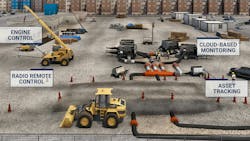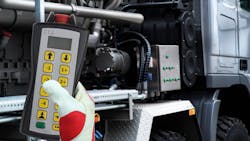How to Bridge the Equipment Connectivity Gap
Key Highlights
In this article, you will learn:
- How retrofit connectivity solutions enhance mixed-fleet management.
- What safety upgrades can be retrofit.
- How to reduce fuel consumption.
- Ways to boost utilization tracking and predictive maintenance.
Emerging technologies can provide today’s construction companies with new insights and control over equipment monitoring, maintenance, worker safety, and more. The relatively new push toward “connected job sites” often favors large contractors with the newest connected equipment, or those with segregated clusters of single-brand equipment, enabling proprietary communication to take place.
A technological gap has thus left some contractors with mixed fleets—the vast majority of construction operations—struggling to achieve the same level of operational coordination and oversight. Advances in retrofit connectivity solutions are eliminating this disparity, enabling any contractor to transform its existing job site into a unified, intelligent, connected operation regardless of equipment manufacturer.
A retrofit solution addresses many fundamental challenges facing equipment-using operations: aging equipment that must remain productive longer due to supply chain constraints, increasing safety requirements in work zones adjacent to traffic, and the need for more sophisticated operational data to manage costs and compliance. Unlike new equipment purchases that lock contractors into single-manufacturer ecosystems, aftermarket retrofit solutions provide the flexibility to integrate diverse equipment makes, models, and ages, while maximizing the utility of its existing capital investments.
The benefits of connected job sites
More on how technology aids asset management
- Sam Williams mines data for fleet efficiencies at William A. Hazel Inc.
- Aaron Mayer explains how to set up a data collection program.
- ISO telematics standard is evolving to include data sharing across job sites.
- AI offers game-changing opportunity for fleet management.
- Machine data feeds could streamline the operations side of the business.
Connected job sites represent a fundamental shift in how fleet managers approach equipment coordination and safety. At its most basic level, a connected job site can provide peace of mind, giving supervisors the tools to stop equipment in emergencies, monitor operational efficiency, and better manage costs through real-time data collection.
Many contractors operate a mixed fleet of equipment accumulated over years of acquisitions and replacement. This creates a patchwork of different control systems, monitoring capabilities, and maintenance protocols that complicate fleet management.
Retrofit connectivity solutions can address these challenges by providing brand-agnostic integration. Whether a fleet includes engines from Yanmar, Kubota, Cummins, or Caterpillar, a retrofit system can interface with most major brands and leverage decades of industry relationships and technical documentation on file to enable cross-platform communication.
The retrofit process varies significantly based on equipment age and complexity. For a highway contractor with 10-year-old equipment, for example, the implementation timeline depends largely on available documentation and the scope of upgrade desired.
The simplest installations—adding wireless emergency stop capability to existing equipment—can be completed in just a few days. These basic safety systems, ranging from $2,500 to $3,000 per machine, provide immediate supervisory shutdown capability across multiple pieces of equipment.
More comprehensive retrofits, involving engine control integration and machine monitoring, typically require two to three weeks of implementation time. These systems, costing between $2,000 and $10,000 per machine depending on complexity, provide anti-idling features, preventive maintenance alerts, and operational data collection.
Training requirements are typically minimal due to the emphasis on automation and simplicity. Many retrofit systems operate behind the scenes, requiring little operator intervention beyond responding to alerts or emergency situations.
Retrofit ROI
The investment structure for retrofit connectivity breaks down into several components. Hardware costs, including installation, represent the primary expense. Software licensing and ongoing fees apply primarily to telemetry systems that require cellular connectivity for remote data reporting.
These ongoing costs range from several hundred to several thousand dollars annually, depending on the complexity of data monitoring and whether integration with existing fleet management systems is required. The ROI timeline varies, but several factors can provide rapid payback.
This technology can address costly fuel-management challenges common on remote construction sites. Rather than constant idling or continuously running equipment at high speed, intelligent engine control systems can automatically adjust speeds based on load requirements, preventing the light-load conditions that can cause expensive aftertreatment system problems.
Consider the cost of a single DPF replacement on modern Tier 4-F engines, which can reach $5,000 to $10,000 or more. Since a DPF is a temperature-dependent device, without sufficient exhaust operating temperatures, the health of every DPF is at risk. In fact, until the DPF is operating well above idling temperature, it’s collecting soot and particulate matter. A clogged DPF restricts exhaust flow, causing increased back pressure. This forces the engine to work harder, potentially leading to damage to the turbocharger, EGR system, and other critical engine components.
When a piece of equipment is out of commission for a few days, contractors face potential costs in rental equipment, project delays, or missed completion bonuses. Intelligent optimum-idling features and engine monitoring systems that reduce soot buildup and prevent DPF failures can pay for themselves with a single avoided repair.
Fleet management benefits
Road building applications
Road building operations present ideal applications for connectivity solutions. Typical highway construction projects involve motor graders, asphalt pavers, vibratory rollers, dump trucks, wheel loaders, excavators, crawler dozers, soil compactors, and articulated haulers, as well as various support equipment—all potential candidates for retrofit integration.
Consider a highway construction project where multiple machines work in coordinated sequence. Connectivity enables real-time communication between manager and machine, helping plan, monitor, collect data, analyze, and optimize the entire process. Machine-to-machine communication allows operators and managers to share operational data, maintaining uniformity across the entire operation.
Remote control capabilities let some equipment operators position themselves optimally around their machines rather than being on them—with limited visibility. This improves both safety and operational efficiency, particularly in confined spaces, or in hazardous situations such as working near steep drop-offs or near active roadways.
From a fleet asset management perspective, retrofit connectivity delivers significant operational improvements, including enhanced preventive maintenance scheduling, improved equipment utilization tracking, and comprehensive cost management.
Asset utilization tracking enables fleet managers to optimize equipment deployment across multiple job sites and identify underperforming assets within their operations. By monitoring actual operating hours, load factors, and idle time across their fleet, contractors can determine which machines are working at capacity and which are sitting unused or operating below optimal levels. This data-driven approach helps managers make informed decisions about equipment allocation, identifying opportunities to consolidate similar machines or reassign underutilized equipment to more demanding projects.
For highway contractors managing large fleets, utilization data can reveal patterns that inform future equipment purchases—showing whether additional capacity is needed in specific equipment categories or if existing assets can handle projected workload through better deployment strategies. The technology also enables more accurate project costing by providing precise equipment usage data for each job, improving bid accuracy and profitability analysis.
Safety and compliance advantages of connected job sites
Safety improvements represent one of the most compelling arguments for connected job sites. Wireless emergency-stop systems enable immediate shutdown of individual machines or entire operations from a control center, tablet, or mobile phone.
If an equipment operator experiences a medical emergency, remote shutdown capability can prevent runaway machines from causing property damage or injuries. The ability to immediately shut down a single machine or an entire operation can prevent accidents, equipment damage, and potential liability exposure that could reach many millions of dollars.
Connectivity also supports regulatory compliance by automating data collection for environmental reporting, equipment inspection records, and operational documentation. Total fuel consumption, operating hours, and emissions data can be compiled automatically rather than requiring manual tracking and reporting.
How to retrofit connectivity technology
A retrofit may integrate multiple specialized technologies to create comprehensive connectivity solutions. At the engine level, controllers provide automated idle management and engine protection features. These controllers interface with both mechanical and electronic engines, offering anti-idling capabilities that automatically adjust engine speeds or shut down equipment when operating conditions could damage them.
For remote operation, transmitters enable operators to control equipment functions from optimal vantage points rather than being confined to operator stations. These handheld units may provide up to 10 programmable functions with real-time feedback, allowing precise control of hydraulic systems, engine speeds, and auxiliary equipment from distances up to 600 feet.
Safety systems center around wireless emergency stop capabilities, enabling site supervisors to control operations from hip-carried transmitters.
Data collection and transmission rely on telemetry that interfaces with engine controllers, PLCs, and various sensors to gather operational information. These units monitor standard parameters like fuel consumption, engine hours, hydraulic pressures, and GPS location while transmitting data through cellular networks to cloud-based platforms.
Integration with existing fleet management systems occurs through API connections that feed real-time data—including location, maintenance requirements and operational metrics—directly into a fleet’s established workflows, enabling seamless adoption without disrupting existing processes.
What to consider when implementing a connected site strategy
For contractors considering connected job site implementation, three key recommendations emerge for successful deployments:
- First, invest in robust, reliable connectivity solutions from partners who provide comprehensive support and safety-rated products. The demanding construction environment requires industrial-grade hardware and responsive technical support.
- Second, focus on integrating data analytics for actionable insights rather than simply collecting information. The goal is operational improvement, not data accumulation. Choose systems that provide meaningful alerts and recommendations rather than overwhelming operators and management with raw data.
- Third, start with high-impact applications that provide immediate value. Emergency stop systems and basic engine monitoring often deliver the fastest ROI while establishing the foundation for more sophisticated capabilities.
As infrastructure spending continues and project complexity grows, connected job sites will become an essential competitive advantage for many construction companies. The advent of rapidly developing AI systems will also provide further advantage to those connected construction fleets.
For contractors competing on larger, more complex projects, connected capabilities can demonstrate technological sophistication and operational maturity that may influence project awards. The ability to provide real-time project monitoring, predictive maintenance capabilities, and comprehensive safety systems increasingly sets leading contractors apart from their competition.
For forward-thinking construction fleets, the future lies not in replacing existing equipment, but in intelligently connecting and coordinating the assets contractors already own. Retrofit connectivity solutions make that future accessible today, regardless of the manufacturer badges on your equipment.
About the Author
Shane Samson
Shane Samson is business development manager for engine & mobile equipment OEM at Cattron, where he specializes in connectivity solutions for construction and industrial applications.


